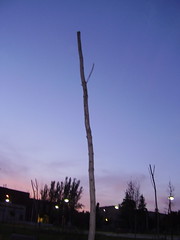Traveling shows
In one of the threads, Ed asks whether there is a relationship between the experience of visiting a museum and a website -- and how the past is "contained" or made "digestible" to the viewers or participants in either case. Where do new media and traditional museums intersect to address difficult questions about the past? Is "interactivity" simply another word for entertainment, as Stephen Mintz suggests?
The documentary Scars of Memory (in Spanish, Cicatriz de la memoria), which was made about the massacre of thousands of peasants in El Salvador in 1932 and particularly about the memories of the survivors and their children, is in my opinion one such place of intersection. The documentary was a result of a collaboration between Jeff Gould and the Museo de la Palabra y la Imagen (MUPI). Dozens of survivors were interviewed over the course of 3 years; while Gould took these interviews as the material for his book of oral history on the massacre, the museum took the footage and made a documentary that loosely parallels the argument of the book. The interesting thing about this project, though, was not only the documentary itself but the way in which it was distributed. It essentially went on tour with the museum throughout El Salvador, traveling to rural areas and screened in community centers, churches, and schools. Screenings would always be followed up with discussion sessions, where people would get quite emotional or confrontational. For a population who to a large degree can't read, especially the older people, this offered them, quite literally, a "say" in the production of history.
I think that the role the museum played in this process was essential. While the film was available online and was made using digital technology, the screenings and discussions were decidedly old school: a projector, lots of plastic chairs, coffee, and conversation. I think it is very important that the post-screening conversations - which could become very heated, I've heard - happened while members of the community tried to make sense of the past together, face-to-face. To what extent could this sort of experience be recreated online in a forum? The museum's role was to moderate discussion but to also get people together to discuss their past, not just the past. The museum moderators never placed themselves as "experts": they, like everyone else, were still trying to make sense of what happened. In fact, these traveling screenings of the film were interactive but they were not about entertainment; people were jointly contributing to the production of history in their communities.
In countries like El Salvador where literacy is not universal and access to computers, let alone the Internet, is not the norm among the majority of people, this kind of hybrid and flexible approach makes sense. There is a highly technologically conscious urban core in the major cities, but elsewhere most people only have access to radio and television. Digitized sources make it much easier (and cheaper) to create audio-visual materials with historical content, but the medium through which it is accessed (or could be accessed) is not digital.
The audio-visual medium opens history up for people who cannot read or write, but who have a stake in how the past is remembered. The museum, in this case, functions as a moderator or facilitator in a dialogue.


0 Comments:
Post a Comment
<< Home